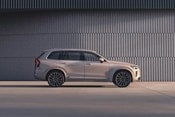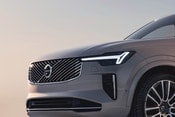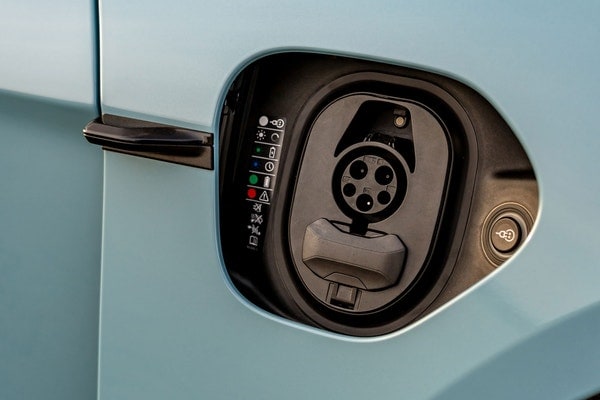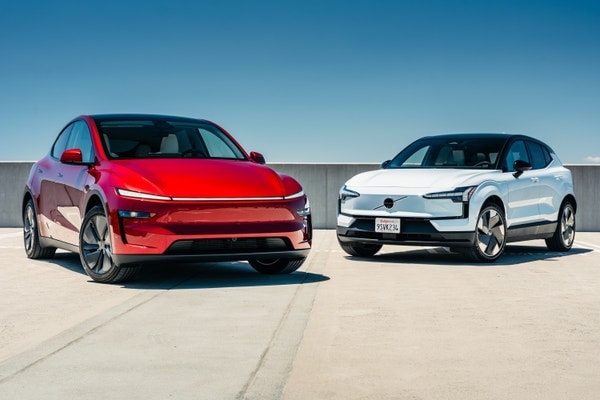The Volvo XC90 three-row SUV is getting a number of small but meaningful updates, and now more than ever, that's crucial. You see, there was a time when Volvo had planned to replace the XC90 with the fully electric EX90, as the company transitioned to being an EV-only automaker by 2030. But with EV demand slowing, Volvo, like many companies, is walking back its big electrification goal. That means the XC90 needs to stick around a bit longer than expected. And since it's currently the oldest vehicle in the Swedish automaker's lineup, an update is long overdue.
But rather than go wild and try to redo the whole thing, Volvo smartly focused on improving the XC90's weakest points. That's why the exterior and interior design doesn't change too much; the XC90's outward appearance, cabin design and material quality have never been issues. Instead, things like chassis refinement, powertrain efficiency and infotainment tech get the most attention. Really, that's all the XC90 needed.
A few little styling tweaks
Up front, the XC90 has redesigned headlights and a new grille, both of which look fresh. There are different wheel designs as part of this update, and it's hard to tell in photos, but the taillights are darkened a bit as well.
You need to see the XC90 in person to really get a sense of the impact the changes make. In a studio in Gothenburg, Sweden, we're able to see the way the new headlights and grille really flatten out the front fascia (that's a good thing). The merging lines in the grille are an especially interesting touch, and the lower fascia is cleaner than before as well.
Inside, the most obvious change is the dashboard layout, where an 11.2-inch touchscreen sort of hovers over the dash, in contrast to the previous 9-inch screen, which was sunken inside. There are redesigned air vents on either side of the screen, and Volvo gave the rest of the cabin a few other updates, including new cupholders, a Nordico upholstery option (you still want the wool, though) and extra ambient lighting.
By the numbers, the XC90 is the same size as it was before, and we'll get both six- and seven-passenger seating configurations in the U.S. with fold-down second and third rows. With all the rear seats folded, Volvo says there's a maximum of 66.2 cubic feet of cargo space.
New tech, but not the newest tech
The 11.2-inch central screen will use an updated version of Volvo's Google-based infotainment software — the same stuff you'll find in the EX30 and EX90. Unlike the EX90, though, which will add wireless Apple CarPlay via an upcoming over-the-air update, the XC90 will still rely on a wired connection.
The screen is much brighter and crisper than before, and the general layout and usability of the Google tech are easy to get the hang of. It's quicker to respond than the XC90's previous Sensus Connect software and relatively easy to use. Still, the actual hardware seems a little weird; we can't help but look inside the XC90 and see a bigger screen slapped over an existing hole in the dashboard. Hey, at least it works well.
The XC90 will have Volvo's Pilot Assist highway driving assistant, as well as a suite of other driving aids. However, it will not have the lane change assistance feature that debuts in the EX90 EV.
Three powertrains, and one's a plug-in hybrid
In the U.S., every XC90 will come standard with all-wheel drive and an eight-speed automatic transmission. From there, buyers can choose from three different powertrains, all of which feature some level of electrification.
The base B5 setup uses a 2.0-liter turbocharged inline-four with mild hybrid assist to produce 247 horsepower and 266 lb-ft of torque. The more powerful B6 variant of this powertrain adds a supercharger into the mix, resulting in 295 hp and 310 lb-ft of torque. Volvo estimates the XC90 B5 AWD can accelerate to 60 mph in 7.3 seconds, while the twin-charged XC90 B6 AWD can do the deed in 6.4 seconds.
Both the B5 and B6 engines now use the Miller combustion cycle in the updated XC90, which is really just a more efficient way of operating. We'll wait until official EPA figures are out to see if there are noticeable fuel economy gains, but right now, the 2025 B5 and B6 models are rated at 26 mpg and 23 mpg combined, respectively.
Like the current XC90, the new one will be offered with Volvo's T8 AWD powertrain, combining the aforementioned turbocharged 2.0-liter I4 with an 18.8-kWh lithium-ion battery. Total system output here is 455 hp and 523 lb-ft of torque, resulting in a 5.1-second 0-60 mph time. Fully electric driving range is estimated to be 32 miles.
Driving the new XC90
Volvo didn't make any big changes to the standard B5 powertrain. Its diligent little four-cylinder engine politely works in the background, making adequate power and no real fuss beyond that. The 247 hp on tap isn't exactly groundbreaking for an SUV this size, but the B5 still makes enough juice to get the XC90 up and moving without issue. I appreciate that the four-cylinder isn't particularly noisy either — it sounds much less raspy than similarly sized engines from luxury competitors like Lexus.
Admittedly, I've never loved the ride quality of the XC90. It always felt less supple over bumps than a luxury SUV should. To remedy that situation, the XC90's new standard suspension setup features frequency-selective damping. The dampers will now mechanically adapt to road conditions and, as a result, provide a more comfortable ride. I tested them for many hours behind the wheel and on a variety of road conditions in southern Sweden; they work very well. The 2026 XC90 is so much more comfortable than before.
Like the B5, there aren't any major mechanical changes to the T8 PHEV, but driving this model quickly reminds me how smooth Volvo's hybrid powertrains are. The XC90's powertrain seamlessly shifts from electric to gas power without any disturbance. It will stay in electric mode for quite some time, but when you plant your foot on the accelerator, the engine kicks in quickly to provide immediate oomph. It is far and away better than, say, a Lexus TX.
The T8 is also pretty darn punchy. Volvo has all but given up on making performance cars, so this powertrain is a refreshing option for drivers who want some pep in their step. The XC90 T8 can be had with air springs, and while that setup is fine, the standard suspension is so well sorted that the air option doesn't really seem worth the extra money. Either way, you'll have a great-riding SUV.
A little more expensive
Full model range pricing is still TBD, but right now, Volvo confirms the updated XC90 will start at $59,745, including $1,295 for destination. That's an $1,850 increase over the current XC90 but not a huge upcharge considering the tech upgrade, all things considered. From there, Volvo offers several trim levels of each powertrain option spanning all the way to the range-topping T8 Ultra, which costs $81,995 with destination.








